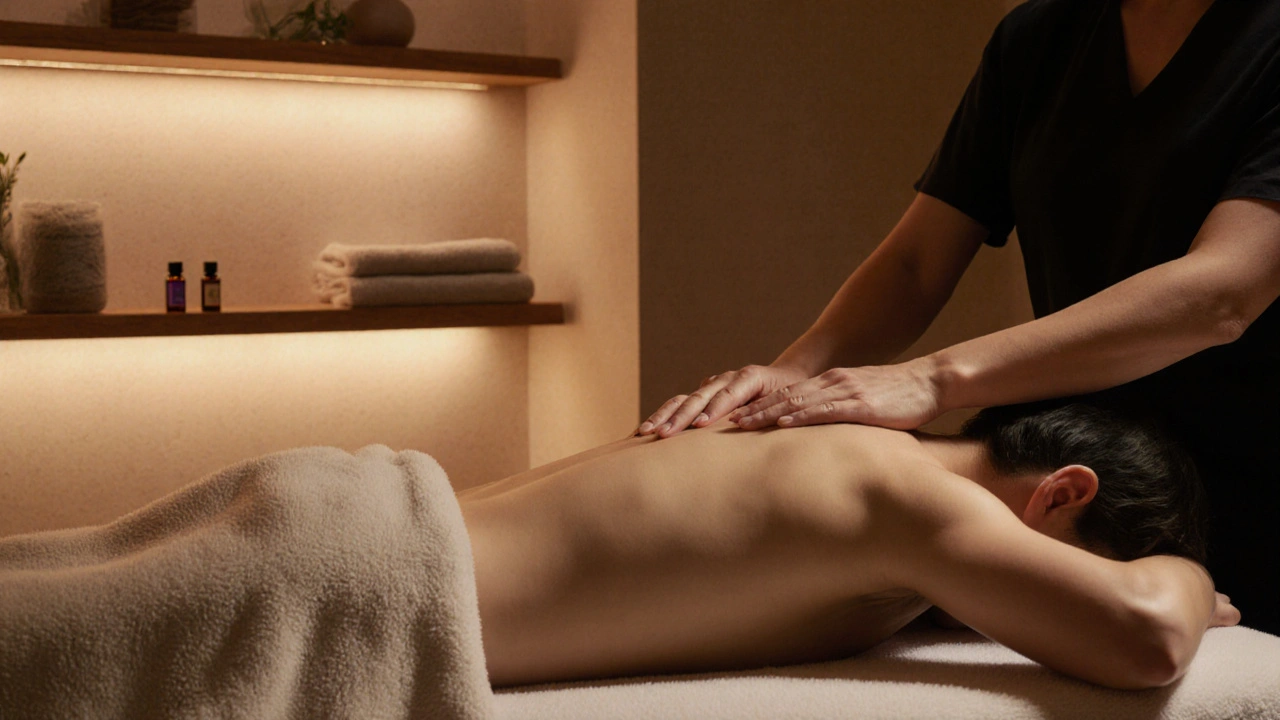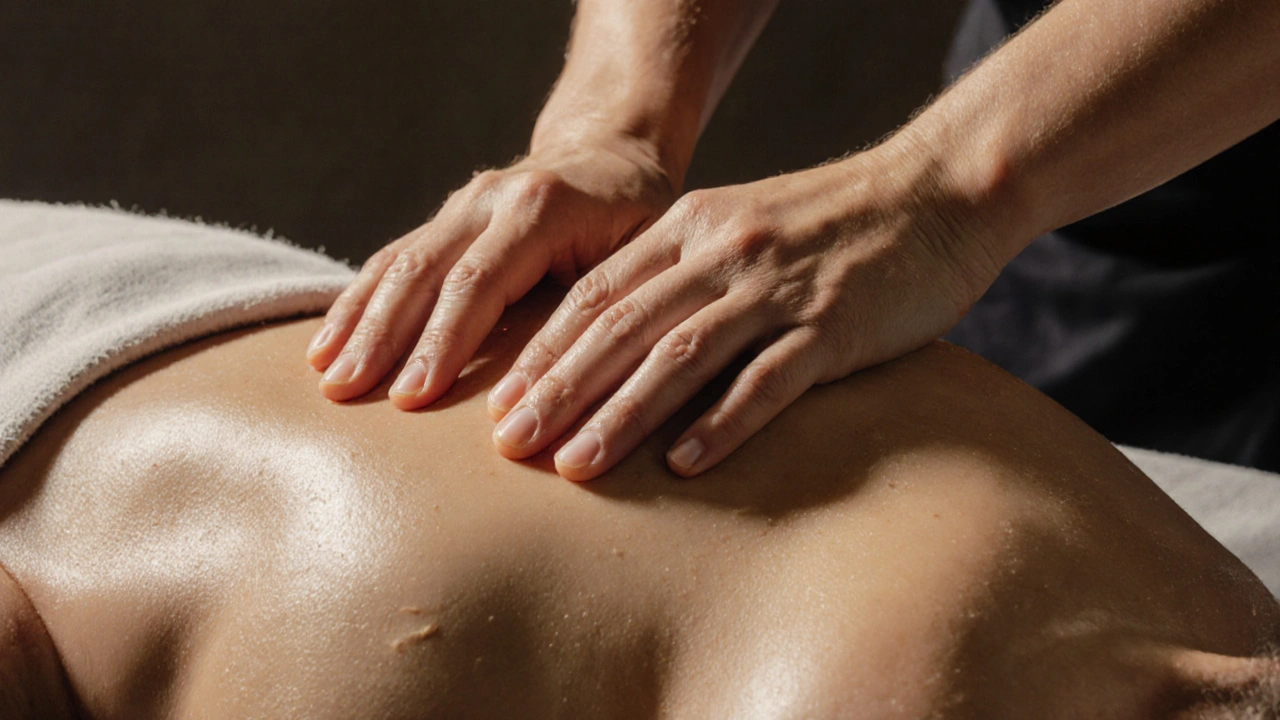Swedish Massage: The Proven Healing Touch for Mind, Body, and Soul
 Nov, 18 2025
Nov, 18 2025
Stress Reduction Calculator
How Regular Swedish Massage Lowers Stress
Based on a 2024 University of Sydney study showing 31% average cortisol reduction per session
Your Stress Reduction Results
Estimated cortisol reduction:
Improved sleep probability:
Emotional control improvement:
Imagine sinking into a warm, quiet room. Soft music plays. The scent of lavender lingers. Then, hands begin to move-slow, steady, confident. They glide over your skin, pressing just enough to melt tension, not enough to hurt. This isn’t magic. It’s Swedish massage. And it’s been helping people unwind, heal, and reset for over 200 years.
What Exactly Is Swedish Massage?
Swedish massage is the most common type of massage therapy in the Western world. It’s not just a fancy spa treat-it’s a structured system of techniques developed in the early 1800s by a Swedish physiotherapist named Per Henrik Ling. He combined movement theory with manual therapy to help soldiers recover from injury. Today, it’s used for everything from easing chronic pain to helping new parents sleep through the night.
Unlike deep tissue or sports massage, Swedish massage doesn’t aim to break down knots with heavy pressure. Instead, it uses five core techniques: effleurage (long, gliding strokes), petrissage (kneading), friction (deep circular movements), tapotement (rhythmic tapping), and vibration. Together, they create a rhythm that tells your nervous system: you’re safe. And that’s when healing begins.
How It Changes Your Body
Your body responds to Swedish massage like a plant to sunlight. Studies from the Journal of Clinical Psychiatry show that just one 60-minute session can lower cortisol-the main stress hormone-by up to 31%. At the same time, serotonin and dopamine levels rise. These are the chemicals behind calm, focus, and even mild euphoria.
On a physical level, the long, flowing strokes increase blood flow. That means more oxygen and nutrients reach tired muscles. Lactic acid, the compound that causes soreness after a workout, gets flushed out faster. A 2023 review in Complementary Therapies in Clinical Practice found that regular Swedish massage improved muscle recovery time by 28% in athletes.
Even your skin benefits. The friction and gliding motions stimulate lymphatic drainage, helping your body remove toxins naturally. People with mild edema or post-surgical swelling often report noticeable relief after just a few sessions.
Why Your Mind Needs It Too
Most people think of massage as a body treatment. But the real magic happens between your ears.
When you’re stressed, your brain stays in fight-or-flight mode. Your shoulders stay tight. Your jaw clenches. You can’t sleep. Your thoughts race. Swedish massage interrupts that cycle. The slow, predictable rhythm of the strokes signals your parasympathetic nervous system to take over. That’s the part of your brain that says: It’s okay. You can relax now.
One client I worked with in Newcastle-a teacher working 60-hour weeks-came in with migraines three times a week. After six weekly sessions, she stopped needing painkillers. "It’s not that the stress disappeared," she told me. "It’s that I finally learned how to let go of it."
That’s the quiet power of Swedish massage. It doesn’t fix your problems. It gives your mind space to breathe so you can face them better.
What It Does for Your Soul
Soul is a word that gets thrown around a lot. But here, it’s real. It’s the part of you that feels disconnected when life gets loud. The part that misses being touched without agenda.
Swedish massage is one of the few places left where human touch is pure, intentional, and healing. No texting. No deadlines. No judgment. Just presence.
In a world where we’re constantly being scanned, swiped, and sold to, this kind of touch is radical. It reminds you: you’re not a task. You’re not a productivity metric. You’re a person who deserves to be held.
Many people cry during their first session. Not because something’s wrong-but because something’s finally right. The weight they’ve been carrying for months, sometimes years, starts to lift. Not because the massage therapist fixed it. But because they let it be felt.

Who Should Try It?
Swedish massage isn’t for everyone-but it’s for more people than you think.
- If you sit at a desk all day and feel stiff by 3 p.m.
- If you’re a new parent who hasn’t slept through the night in months
- If you’re recovering from an injury and need gentle movement
- If you’re anxious, overwhelmed, or just feel emotionally drained
- If you’ve never tried massage before and want to start with something soothing
It’s not recommended if you have open wounds, blood clots, or severe osteoporosis. But for most people? It’s safe, simple, and deeply restorative.
What to Expect in Your First Session
Your first session lasts about 60 to 90 minutes. You’ll lie on a padded table under a warm towel. The therapist will leave the room while you undress to your comfort level-most people keep their underwear on. You’ll be covered at all times except for the area being worked on.
The therapist will ask about your goals: stress relief? Muscle soreness? Better sleep? Then they’ll adjust pressure and technique accordingly. No pushing through pain. No "no pain, no gain" nonsense. If it hurts, say so. Good therapists welcome feedback.
Most people feel deeply relaxed during the massage. Some fall asleep. Others feel a strange sense of warmth spreading through their body. Afterward, you might feel a little lightheaded. Drink water. Rest. Avoid caffeine or heavy meals for a couple of hours.
You don’t need to feel "better" right away. Some people notice changes after one session. Others need three or four. It’s not about instant results. It’s about building a habit of care.
How Often Should You Get It?
There’s no one-size-fits-all answer. But here’s what works for most people:
- For stress relief: once every two weeks
- For chronic tension or pain: once a week for 4-6 weeks, then monthly
- For maintenance: once a month
Think of it like brushing your teeth. You don’t wait until your gums bleed. You do it regularly because it keeps things healthy.
Many people start with weekly sessions and gradually space them out. Some keep it as a monthly ritual-like a reset button for their nervous system.

What Makes It Different From Other Massages
Not all massages are created equal.
Deep tissue targets knots with intense pressure. Sports massage focuses on performance and flexibility. Thai massage uses stretches and acupressure. Shiatsu applies finger pressure along energy lines.
Swedish massage is the baseline. It’s gentle. It’s rhythmic. It’s designed to relax, not repair. That’s why it’s the perfect entry point. Once you learn how your body responds to touch, you can explore deeper therapies-if you want to.
But for most people? Swedish massage is enough. It’s the foundation. The daily walk. The quiet morning coffee. The thing you do not because it’s trendy, but because it works.
Real Results, Not Just Feel-Good Stories
Let’s talk numbers.
A 2024 study by the University of Sydney tracked 120 adults with moderate to high stress levels. Half got weekly Swedish massages for eight weeks. The other half didn’t.
After two months:
- 78% of the massage group reported better sleep
- 72% said their anxiety levels dropped noticeably
- 65% had fewer headaches
- 89% said they felt more in control of their emotions
None of these results came from pills, apps, or meditation retreats. Just hands. And time.
Where to Find a Good Therapist
Not all massage therapists are trained the same. Look for someone certified by a recognized body like the Australian Association of Massage Therapists (AAMT) or equivalent in your country. Ask if they specialize in Swedish massage-not just "relaxation massage," which can mean anything.
Read reviews. Pay attention to comments about communication, hygiene, and whether the therapist adjusted pressure when asked. A good therapist will never assume you like deep pressure. They’ll check in.
And don’t be afraid to try more than one. Finding the right therapist is like finding the right friend. It takes a few tries.
Final Thought: You Deserve This
Swedish massage isn’t a luxury. It’s a biological necessity.
Your body was designed to move, rest, and be touched. Modern life takes all that away. We sit. We scroll. We rush. We isolate. And then we wonder why we feel so heavy.
This isn’t about spending money. It’s about reclaiming a basic human need: to be held, gently, without condition.
You don’t need to be broken to deserve this. You just need to be human.
Is Swedish massage painful?
No, Swedish massage is not supposed to hurt. It uses light to medium pressure, with smooth, flowing movements. If you feel pain, tell your therapist. Good massage should feel soothing, not punishing. Pain means you’re tensing up, not relaxing.
How long does a Swedish massage session last?
Most sessions last between 60 and 90 minutes. A 60-minute session covers the full body, while 90 minutes allows for more time on areas like the back, shoulders, and legs. Shorter 30-minute sessions focus on specific areas like neck and shoulders.
Can I get a Swedish massage if I’m pregnant?
Yes, but only with a therapist trained in prenatal massage. They’ll use special positioning and avoid certain pressure points. Many pregnant women find Swedish massage helps reduce swelling, back pain, and anxiety during pregnancy.
Do I need to be naked during the massage?
No. You’ll be covered with a towel at all times, and only the area being worked on will be exposed. Most people keep their underwear on. The therapist will leave the room while you undress and will knock before re-entering. Your comfort and privacy are priorities.
How soon will I feel the effects?
Many people feel relaxed immediately after the session. Improved sleep and reduced muscle stiffness usually show up within 24 hours. For lasting changes-like lower stress levels or fewer headaches-it typically takes 3-6 regular sessions.
Can Swedish massage help with anxiety?
Yes. Studies show it lowers cortisol levels and increases serotonin and dopamine-chemicals linked to calm and happiness. It’s not a replacement for therapy, but it’s a powerful tool to help your nervous system reset and feel safer.
